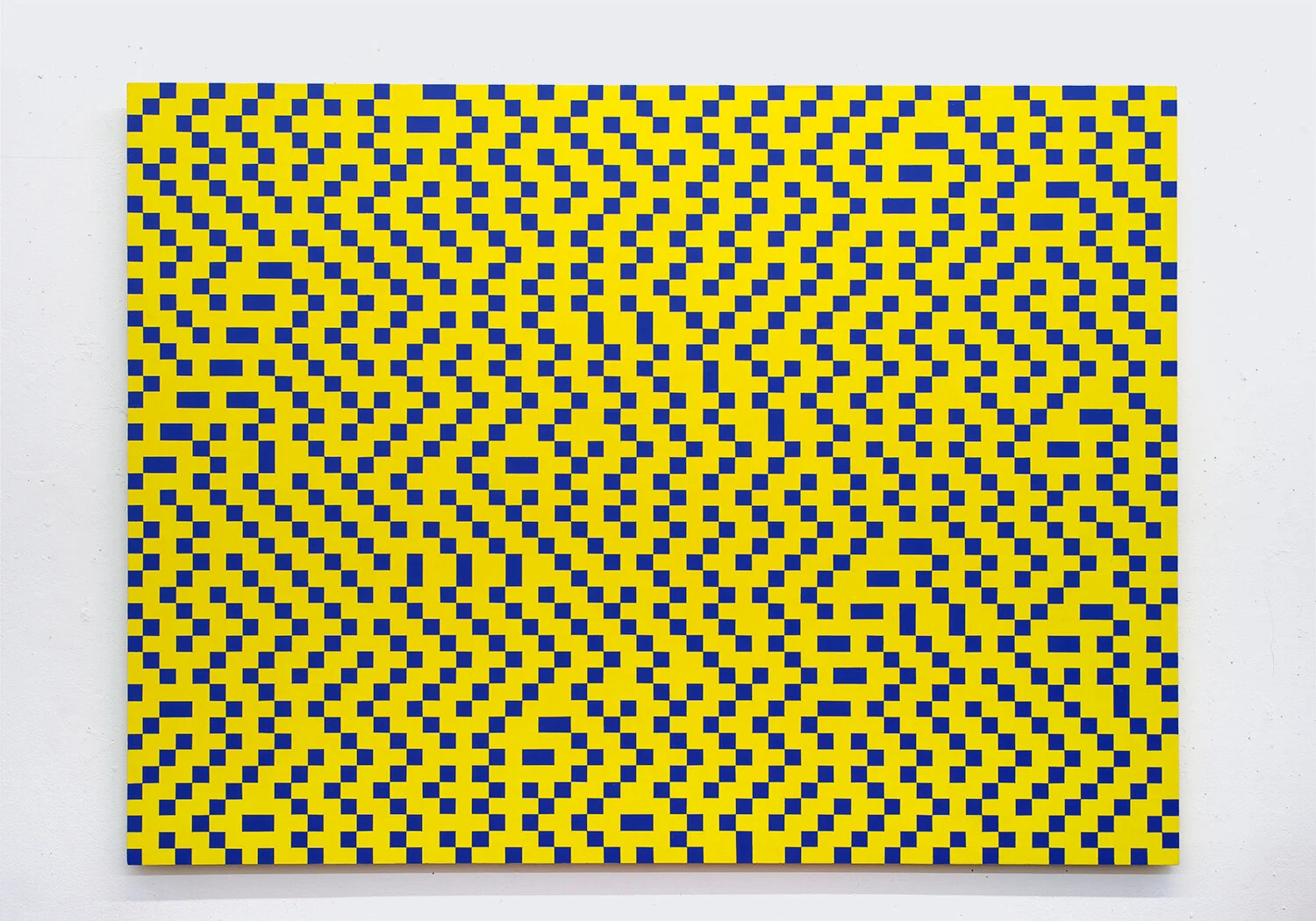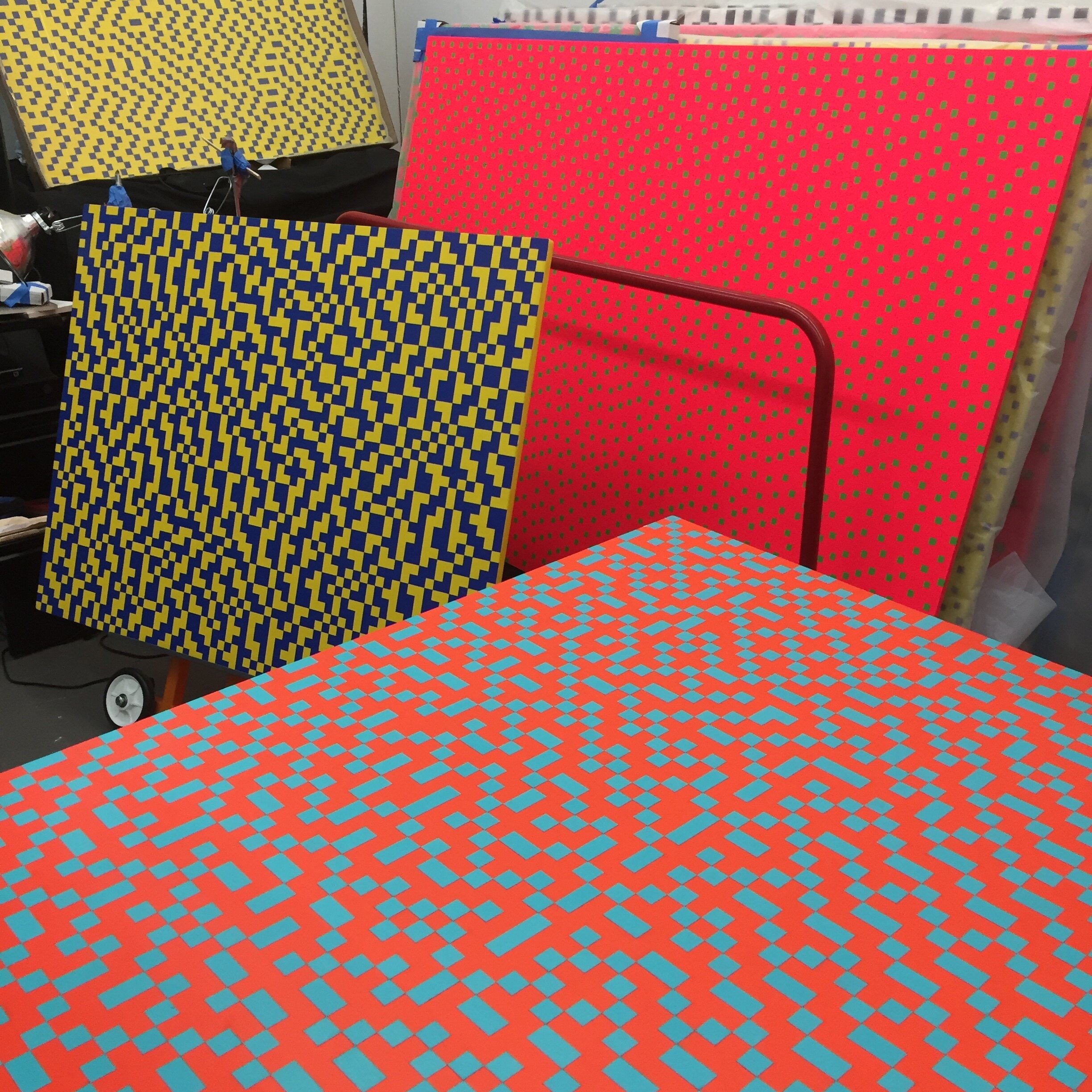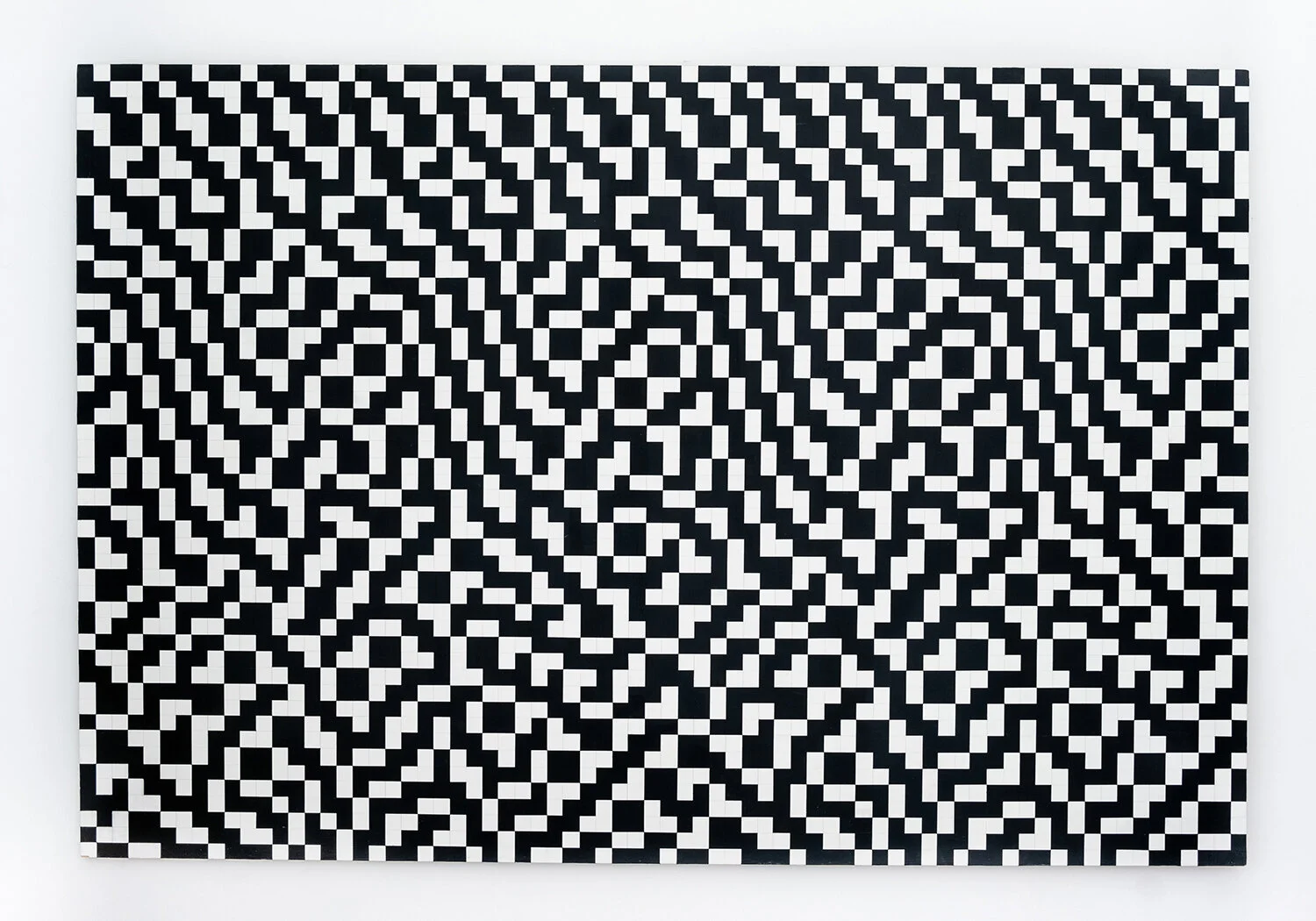Saratoga, 2016. © Daniel Temkin
Daniel Temkin uses code and other devices to manipulate how we understand photography and visual perception.
I first came across Daniel Temkin's Straightened Trees series in late 2016 when I was curating "Future isms," Humble's exhibition that used utopian/dystopian images as a metaphor for the dark times and uncertainty surrounding the United States presidential election. Buildings and power lines twist and contort around artificially "corrected" trees, calling into question what is real, what's human-made, and how we conjure a landscape-ideal. Temkin's trees, which he makes by using an algorithm and code injection to alter the digital structure of a straight, large-format photograph respond to a need to control a messy world. A critique of perfectionism. A landscaping rhinoplasty with disastrous consequences.
Like Straightened Trees, Temkin's larger practice is all about the conflict between human thought and logic. It reflects the two worlds he straddles: photography and computer programming. In a recent exhibition at New York City's Higher Pictures Gallery, he paired his trees against his new series Dither Studies.
For those, like myself, who are likely unaware of what "dithering" is, it's one of the most fundamental algorithms of contemporary photography, dating back to the 1970s when it was used to translate color or grayscale images to black and white pixels. The process allows a limited color palette to take on the look of a gradient image. Kind of like a highly pixelated ombre sky. Temkin hand renders these images in acrylic on panel, turning each pixel into a square of color, with highly psychedelic results. While visually dissimilar, Dither Studies relates to Straightened Trees in its push to pull apart the image-making process, confronting the strange and illogical structures of human and machine-based perfectionism.
A presidential term (and a much more frightening world) deep into my admiration for his work, Temkin and I spoke to bring it together.
Jon Feinstein in conversation with Daniel Temkin
Installation view from Daniel Temkin’s virtual exhibition at Higher Pictures, NYC.
Jon Feinstein: For a while, I thought your straightened trees were just "perspective-corrected" in Photoshop, but I learned that the process is much more complex involving code.
Can you break it down for me?
Daniel Temkin:Yes, so the straightening involves both Photoshop correction and custom code I wrote for the project. The Photoshop piece straightens the major curves of the tree, in sections starting at the major turning points of the curve; anywhere the tree changes direction. That work is mostly automated now, with scripts I've written for Photoshop, although they are not as reliable as manual work, so I use a mix of both.
The second part straightens the tree at the detail level, where it no longer needs rotating, just pixels pushed to get it perfectly centered and symmetrical. This is done completely with code I wrote in C#, based on an earlier sketch in Processing. Processing was great for working out the idea initially, but can't handle the large image files for the trees.
I learned recently that students in a "recoding" class at MIT took a stab at recreating my tree-straightening code, alongside work by some of the great algorithmic artists like Vera Molnar. They broke the problem down in a similar way to me: find the edges of the tree, apply transformations, then push pixels by row—but implemented each step differently. This is the fun of coding: taking a process that feels complex and simplifying it into steps that can each be individually accomplished.
Summer Island, 2016 © Daniel Temkin
Installation view from Daniel Temkin’s virtual exhibition at Higher Pictures, NYC.
Feinstein: That’s amazing. Building on that, I see some obvious tie-ins to you shooting with a 4x5 - mainly the “analog” perspective control, and how it plays with the coding in post-production. Why is it important for you that straightened trees were photographed with a 4x5 camera?
Temkin: I first moved to 4x5 for purely technical reasons. The project began when I was in Berlin for Transmediale in 2013. Sitting at breakfast one morning, I saw a tree out the window that was twisted in such a way that, were it straightened, the snow would seem to stick to the sides in an unnatural way: in clumps on the left, then right, then left again. I photographed it with the digital SLR I had with me. Back in the US, I straightened it using a rough version of the process in the first answer.
The final image was interesting but didn't completely work. For one thing, it felt too pixely; when pixels are no longer adjacent with their former neighbors, the smooth gradients in a cluster of pixels dissolve, creating jumps in color from one pixel to the next. It drew too much attention to the lattice of pixels we see the image through, rather than the true subject of the work: the tree and landscape.
W. Hastings, Vancouver 2017 © Daniel Temkin
Feinstein: How did 4x5 change things?
Temkin: By moving to 4x5, I now had access to far more resolution, so that the buildings undulate smoothly, even in large prints. This moves the focus of the work away from screens or resolution (and a potential digital-materialist reading of the work I was less interested in). This could potentially have been achieved digitally with a very complicated camera set-up, but I enjoyed the relative simplicity of 4x5. I can walk around with the camera in a rolling suitcase, through neighborhoods in a new city, looking for trees.
Another thing happened with the move to large format, however: the photos moved into an indeterminate time. There are visual clues that mark the series as contemporary—for instance, the warping of the trees feels reminiscent of my beginnings in glitch art—but the visible edges of the negative, along with the film grain and black and white, suggest images from the late 70s or earlier. To avoid resolving this ambiguity, I usually avoid shooting people and cars, which tend to mark the era.
Calvary Cemetary, 2019 © Daniel Temkin
Photoshop Diffusion Dither, 39% Teal 2019 © Daniel Temkin
Feinstein: How and why did you start incorporating code into your work?
Temkin: From 2006 to 2011 or so I was heavily involved in glitch art practice: "hacking" images by messing with the data behind them using custom code, or by deliberately misusing tools designed for other purposes. My background is a mix of photography and programming, and glitch brought them together. It offered a release from the rigor of programming, where code either works or doesn't, instead offering a scenario where something interesting might happen if you're lucky, but you never have full control over it. It's what Curt Cloninger describes as "painting with a very blunt brush that has a mind of its own."
When we write code, we translate our own (human) intent into the foreign language of logic. This is always a flawed process, because we are not logical beings, leading to the inevitability of bugs. Glitch does away with even the attempt to harmonize logic and intent; the only intent is to see where the process leads one.
Two Row Sierra, 50% Blue (Approximation of Green). © Daniel Temkin
Feinstein: How did your work evolve from there?
Temkin: From there, I created a series of programming languages that similarly challenge the making-coherent of programmatic intent. In my language Entropy, data decays the more that you use it, meaning it will never do exactly what you want—but you can get a gesture across to the user of your program before your data falls apart. I explored the same idea from the opposite angle with FatFinger, a dialect of JavaScript called FatFinger where you can spell everything wrong and yet the code still "works," even if it doesn't do exactly what you had intended. Alongside creating my own languages, I've written up work by other artists, hackers, and poets designing programming languages in my blog esoteric.codes (named for "esoteric," the class of programming languages that includes all the deliberately "non-practical" languages).
The Trees build on this same line of thinking. Occasionally I'm asked if the Trees were straightened in the darkroom. Even if that were possible—even if I had straightened them non-digitally—the impulse to make the trees straight is a digital one, a perfect alignment of space and form that only makes sense when you've spent a lot of time with computers. The computer allows us to draw perfect squares in perfect alignment. That is a computational mode of thinking; what is satisfying about a perfectly straight tree is in that same false sense of order that lies behind the code we write.
Summa Street, 2020. © Dainel Temkin
South Dixie Hwy, 2020. © Daniel Temkin
Feinstein: You describe your practice as evaluating the "clash between systemic logic and human irrationality" - can you build on this?
Temkin: My work as a programmer has convinced me that logic is pretty alien to the human experience. Even simple code can have complex repercussions in a logical space that requires precision. While technology can seem impressive, it is always flawed; this is not controversial for programmers, as bugs have long been accepted as its inevitable cost, and I think is becoming more familiar to non-programmers. In other words, code, in general, does not work
Computer Scientist Joseph Weizenbaum, best known for creating the Eliza chatbot, described the cycle of compulsion of programming: the machine is completely under our control, and yet, again and again, fails to do what we want it to, implicating us, the programmers. This is where coding seems like linguistic magic; we speak an incantation, but we say it wrong and mayhem ensues.
Since we can't really force ourselves to be more logical, we instead become compulsive about the things we CAN control; this leads to the cliches of programmers arguing over tabs vs. spaces etc. We're particular about expressing ourselves to the machine in an organized way as if that clarity will give us control over what the code ultimately does.
The perfect centering and making-symmetrical of a tree builds on this same impulse.
In the studio….
Atkinson Dither, 48% Green, 2018 © Daniel Temkin
Feinstein: Did pairing your colorful, glitchy pattern heavy Dither Studies with Straightened Trees for your recent exhibition at Higher Pictures give you new insights into the work?
Temkin: The Trees and my Dither Studies bring this thinking back into the photographic space: examining logic and compulsiveness and how they arise in our relationship with formal systems.
The first step of my Dither Studies is algorithmic. Dithering is a 1970's technology still in wide use today, where a small palette of colors approximates an image made up of a large color set. In the Dither Studies, I offer not a photographic image, but instead a solid color. I dither this solid color with a palette made up of two complementary colors, meaning colors that will never visually recombine into a third. This offers the machine an impossible task, which it attempts by generating a complex pattern of pixels.
The second step is my hand-rendering the results on wooden boards, painstakingly recreating the pattern with acrylic paint. This creates a more immediate connection between human and algorithm, as I'm carrying out the programmatic instructions in the physical act of painting it. It also neutralizes the ephemeral aspects of technology: the monitor we might show the dither on, or the inkjet printing process. Like the Trees (shown as silver gelatin fiber prints), a work that engages with technology is moved to a medium less associated with it.
Feinstein: These aren’t exactly photographs, but they are “photographic…”
Temkin: The Dithers are a form of cameraless photography, done without conventional equipment. When I began this project, I thought about photographers like Liz Deschenes who isolates a single aspect of photography. The dither is perhaps the fundamental photographic algorithm. It also calls back to early computer artists like Vera Molnar and Hiroshi Kawano, who painted their pieces by necessity, as there was not an easy way to automate rendering of their designs.
These aspects of the photographic nature of the Dithers became more apparent in the pairing. With the trees, the photographic element that came to the fore was how they function as street photography. In our discussion about the show, Andrea Grover (of Guild Hall) pointed out that most of the trees are shot from a car's point of view. This was because I needed to have a background that had human-made objects —e.g. trees or telephone wires—to show how the trees had been straightened.
With the early pieces, particularly the ones I shot in LA, I was pretty shameless about blocking off part of the street with my car in order to set up the camera in order to shoot the tree I wanted (people usually thought I was making a film). This, plus the fact that all the images included in the final series were shot in North America, emphasizes the kind of photographic road trip (eg Lee Friedlander's America By Car) that I had always respected but never consciously replicated.
Atkinson Dither, 57% Grey © Daniel Temkin
Feinstein: In its initial pre-pandemic form, Dither Studies and Straightened Trees touched on issues of landscape perfectionism, control, and the interaction between natural and man-made among other ideas. Do you see it taking on a new meaning given how COVID has changed our relationship to nearly everything?
Temkin: Yes, as has been widely noted, in 2020 climate disaster is no longer a looming abstract threat but has arrived, and COVID is giving us a taste of this impending doom. A month ago I was in Connecticut, emptying out a fridge full of spoiled food, after the town experienced its first-ever tornado.
That sense of impending doom definitely haunts the images to some extent now. There is an exchange of form between the human-made structures and the trees themselves, but it's only the human-made structures that appear unnatural in that trade. There is a resilience to the tree.
Feinstein: What do you hope viewers – from those with limited to no understanding of your technical process to those with art+coding backgrounds – come away with after engaging with your work?
Temkin: A chance to reflect on systemic thinking and the anxiety around it—and perhaps how we use technology to feed that anxiety.

















